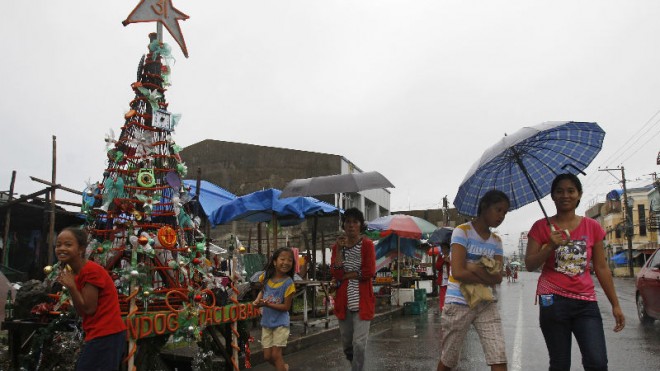TACLOBAN CITY, Philippines—The skies over this typhoon-devastated city were lighted up with bright colors even for only 30 minutes as its people welcomed the New Year with a fireworks display.
Mayor Alfred Romualdez said the fireworks, donated by the Dragon Fireworks of Bulacan to the city government and its people, helped people forget even for a while that they remain in dire need of help, nearly two months since Supertyphoon Yolanda (Haiyan) wrecked the city last November 8, claiming over 2,000 lives and destroying property worth over P18 billion in the city alone.
“We’ve been doing this (fireworks) every year but tonight is special because of what happened to us, which is very gloomy for all of us. It somehow makes us forget,” the mayor said minutes after the fireworks ended.
Romualdez led over a thousand people, including members of various international humanitarian groups, in the countdown to the New Year held on the grounds of City Hall.
For 30 minutes, colorful and whistling pyrotechnics lighted up the skies above the city, which had been experiencing intermittent rain since Christmas, as the people clapped their hands and shouted in glee as the fireworks exploded in the night sky.
Dr. Schiovenne Ruddel, an Australian working for the World Health Organization, said she found it “incredible” that the people managed to celebrate the New Year despite what had happened to them.
“It’s been obviously a terrible tragedy to all of you but it is really good to see the spirit. And that is incredible. And that makes me proud to be a person,” Ruddel said.
Prior to the lighting of the pyrotechnics, singer-songwriter Rico Blanco rendered several songs, which included “Bangon,” a song he composed when Metro Manila was hit by Ondoy’’s devastating floods in September 2009. He said that the song also applied to the situation of Tacloban and the rest of Eastern Visayas battered by the world’s strongest typhoon on record.
He praised the people’s resilience in confronting their sorrows and trying to stand up and to live to normal lives. Blanco earlier visited several evacuation sites in this city and in other parts of Leyte where he held impromptu concerts, singing two to four songs per visit to a shelter.
“I don’t have any inspiring message to them. They are the ones inspiring us because of their courage and their strength,” he said.
Blanco, who arrived in Tacloban on December 31, visited evacuation centers in the villages of San Jose and Nula-tula in the morning and travelled to the towns of Mayorga and Tanauan before returning here for the countdown to the New Year event.
In his stops at the evacuation centers, Blanco sang his famous songs, Elise, Panahon Naman ng Pag-ibig, Liwanag sa Dilim, and Bangon.
While at the Tanauan Elementary School, temporary home to 180 families (930 persons), he talked with some of the evacuees and gave them encouraging words, urging them not to lose hope.
He also posed with several children as he sang a song of international aid organization Oxfam International, “Wash,” which he translated to Waray.
Blanco’s mother is a native of Carigara, Leyte. It was Oxfam that brought Blanco to the city, after he tweeted Oxfam asking if he could help them on their humanitarian mission for the Yolanda victims.
The United Kingdom-based organization has been providing hygiene kits and latrines, among others, to the typhoon victims.
Romualdez said he would always be grateful to the various international groups and the national government for helping Tacloban and its people.
“Let us not forget to thank those who have helped us and let us show them that we appreciate their help by standing up as soon as we can get back on our feet,” Romualdez said.


